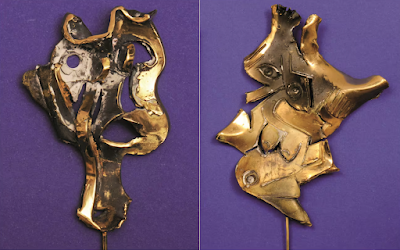 illicit antiquities,illicit trafficking,J. Bagot Arqueología Ancient Art Gallery,Spain
illicit antiquities,illicit trafficking,J. Bagot Arqueología Ancient Art Gallery,Spain
 No comments
No comments
Spain's antiquities dealer arrest and the importance of facts-based reporting
 |
| TEFAF Maastricht 2022 Image Credit: ARCA |
Earlier this week, ARCA published an article building on an announcement made by Spain's Ministry of the Interior which involved the identification of a looted Egyptian object. This investigation involved the Policía Nacional in collaboration with the Dutch Politie, and the expertise of forensic scholars, as well as the assistance of cooperating dealers and the support of art fair personnel. These combined efforts resulted in the voluntary handover of the trafficked artefact in the Netherlands, as well as the reported arrest of a Barcelona-based ancient art dealer who, although unnamed by the authorities, was stated to have been charged with money laundering, smuggling, and document falsification.
ARCA's article touched on its own research into the circulation of this suspect antiquity and to the object's identified Spanish handler In it, I named the dealer whom I (too) had ascertained as having been in possession of this piece after it arrived to Spain from Bangkok before being sold onward to other ancient art dealers in Germany and Switzerland.
Shortly following the Spanish announcement, the bulk of the reporting by mainstream media covered this investigation by simply regurgitating the Spanish government's official press release. ARCA, being a research-based organisation which specifically examines (and sometimes reports on) forensic crimes that have an impact on art and artefacts, opted to provide more detail, both about the object itself and its first seller, while also ensuring that in doing so we haven't compromised the work of international police forces.
Too frequently, trafficked artefact reporting becomes routinely formulaic, giving readers cursory information on an object's country of origin, value, age, and the names of involved agencies responsible for that object's recovery. In these, the artefacts themselves take second stage, reduced to photo opportunities, frequently overshadowed by fancy diplomatic handshakes, whereas the story of the piece itself, its trafficking journey, its good faith and bad faith handlers and its place in history are left with only vague assumptions. Much in the same way, archaeologists and art historians lament the loss of context when an artefact is extracted from its find spot during a clandestine excavation.
 |
| Basic shapes of block statues |
Likewise, when describing this partial 18th Dynasty Egyptian block statue most of the news articles reduced the artefact to its period of creation, i.e.m "a stolen Egyptian sculpture dated from 1450 BCE" or speaking to its rudimentary aesthetic characteristics i.e., "an Egyptian head". Smuggled clandestinely, often over great distances and through multiple transit countries, by the time antiquities such as this one arrive on the ancient art market to be displayed in glittering European art galleries and art fairs, they are often no longer intact.
In this case, the less informed buyer, might appreciate this sculpture's beautiful depiction of the head of an Egyptian male. I, on the other hand, saw its remains as evidence of a crime scene, knowing that the now anonymous severed head, had likely been hacked off or deliberately broken at the shoulders, leaving this once complete representation of a man, absent his body.
During Egypt's Eighteenth Dynasty, the artisan who sculpted this black-granite representation of a once-living human would have worked the hard stone with care and precision, respectfully expressing the belief that the deceased person's Ka, his eternal life force, once separated from his earthly body at death, would be able to travel between the worlds of the living and the dead, finding his eternal home inside this single memorial block statue created expressly for him. Carved to represent the likeness of the deceased and placed inside a sanctuary, had this head remained with the rest of its body, we might also have learned, through its inscriptions, the name of the esteemed person this sculptor sought to portray when creating this artwork.
But why the need for a second article?
Over the past several days there has been scattered chatter over various social media sites where the veracity of my statements regarding who the arrested Spanish dealer was have been the subject of discussion.
Art News journalist Karen Ho, doing her best to be report the news and to remain impartial to the contentious subject wrote:
...the Association for Research into Crimes Against Art, has claimed in a blog post that the individual in question is Jaume Bagot Peix, operator of the J. Bagot Arqueología gallery in Barcelona, Spain.
Art lawyer Justine Philippart, when pointed to the ARCA blog article, stated on Linkedin:
This article is fake news. Nothing is true. Thus, for example, Mr. Bagot was not arrested.













































